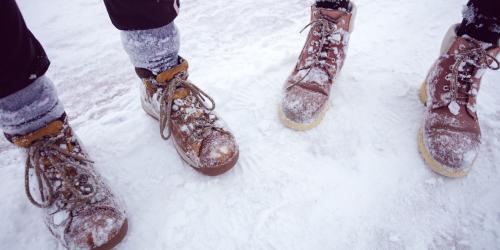According to the government of Alberta, on average more than 1,170 pedestrians are injured each year in collisions and 43 of those injuries are fatal. Even though it’s “technically” spring, weather conditions still aren’t stellar and you will likely need to do some walking outdoors. Whether it’s to escort your children to school, make your daily commute, or getting in some exercise, following these three safety tips each time you venture out can help you avoid becoming a tragic statistic.
Plan Your Route and Make it Known
Extreme weather conditions make it essential to plan ahead. It’s smart to let someone know where you are going, what time you will be back, and what route you plan to travel.
When planning your trip, take these factors into account:
- Route: Take familiar routes in the winter. Snow and ice can hide potholes, curb edges, and other tripping hazards. Put off the urge to explore until after the ice melts.
- Lighting: If you will be out and about in the early morning or evening, only travel in well-lit areas. Adequate lighting means drivers will be able to see you, you’ll be safer if you encounter dangerous people, and you’ll be more likely to see patches of ice before you slip on them.
- Emergency Services: Make sure you travel to accessible areas. Be sure to bring your cell phone with you or carry change for a payphone in case you are injured or get lost while you are out.
Your plan can be as simple or as detailed as you like. Just be sure you are comfortable with your personal safety before you leave your home.
Dress for Success
If you plan to do a lot of walking while it’s cold out, invest in a quality coat, gloves, and footwear. You may also want to purchase grips for the soles of your shoes, padded socks or snow pants to protect you from nasty falls, and a balaclava or earmuffs to guard your head.
Your clothing needs to protect you from the cold weather and interact well with your environment. When dressing for winter conditions consider:
- Distance: How far do you plan to go? Your favourite runners may make the trip down to the mailbox, but if you’re going any farther you’ll need shoes with a deep tread. Invest in heavy-duty boots.
- Visibility: Storm conditions or snow glare can make pedestrians all but invisible to motorists and other travellers. Dress in brightly coloured or reflective clothing so that you are visible no matter the conditions. If you are travelling during the day, a cheery scarf will likely be enough, but you may need to wear reflectors, white, or a neon colour if you are walking at night.
- Mobility: On a walk to the workplace, it’s okay to bundle yourself up to the point of near immobility. But if you are travelling with small kids or near a major roadway, you never know when you’ll need the use of your hands. If you plan on being out in the cold, always dress in layers that you can remove and transport without too much trouble.
Keep in mind, the wrong winter gear can expose you to frostbite or serious injury, so dress wisely.
Be Aware of Your Environment
In the winter, more than any other season, it is vital to remain aware of your surroundings. Before you go out, check that your vision and hearing aren’t obstructed by your hat, glasses, or face mask.
As you walk, listen for any unusual noises and stay alert. A little observation can prevent accidents of all kinds. Each time you travel on foot in the winter, pay attention to:
- Weather Warnings: Always check the weather before you leave the house. Checking can seem inconvenient, but failing to factor a winter storm warning into your plans may leave you stranded out in the snow.
- Traffic Conditions: Pay attention to traffic even when you don’t plan to drive. Congested areas can produce frustrated and careless drivers, which spells trouble for pedestrians. When you can, walk on the sidewalk. When you must walk on the roadside, walk against the flow of traffic and in a low-activity area.
- How You Walk: If you try to walk as usual on slick surfaces, your body must support its weight at an angle. This increases the likelihood of a fall and may strain your muscles. Instead, walk flat-footed and keep your center of gravity above your front leg (like a penguin). It may feel awkward at first, but it will increase your stability and confidence while walking on ice.
If you are aware of your environment, you are less likely to encounter dangerous situations due to the weather, other travellers, or motorists.
You don’t have to stay cooped up just because it’s cold outside. Follow these tips to keep you, and your fellow travellers, safe through winter and spring conditions. However, if you’ve been involved in a motor vehicle accident as a pedestrian, our team of lawyers are always available to discuss your options regardless of the severity of your injury.
Note: This blog post was originally published in March 2017 and has been updated with relevant information and materials

